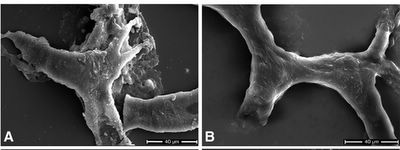Abstract: Soft tissues are preserved within hindlimb elements of Tyrannosaurus rex (Museum of the Rockies specimen 1125). Removal of the mineral phase reveals transparent, flexible, hollow blood vessels containing small round microstructures that can be expressed from the vessels into solution. Some regions of the demineralized bone matrix are highly fibrous, and the matrix possesses elasticity and resilience. Three populations of microstructures have cell-like morphology. Thus, some dinosaurian soft tissues may retain some of their original flexibility, elasticity and resilience.

Branching vessels found in bone matrix of T. rex (A) and ostrich (B)
From the NC State University Press Release:
Dr. Mary Schweitzer, assistant professor of paleontology with a joint appointment at the N.C. Museum of Natural Sciences, has succeeded in isolating soft tissue from the femur of a 68-million-year-old Tyrannosaurus rex. Not only is the tissue largely intact, it’s still transparent and pliable, and microscopic interior structures resembling blood vessels and even cells are still present.For color photos of the soft tissue structures read the article covering the story in Geotimes HERE.
All bone is made up of a combination of protein (and other organic molecules) and minerals. In modern bone, removing the minerals leaves supple, soft organic materials that are much easier to work with in a lab. In contrast, fossilized bone is believed to be completely mineralized, meaning no organics are present. Attempting to dissolve the minerals from a piece of fossilized bone, so the theory goes, would merely dissolve the entire fossil.
But the team was surprised by what actually happened when they removed the minerals from the T. rex femur fragment. The removal process left behind stretchy bone matrix material that, when examined microscopically, seemed to show blood vessels, osteocytes, or bone building cells, and other recognizable organic features.
Since current data indicates that living birds are more closely related to dinosaurs than any other group, Schweitzer compared the findings from the T. rex with structures found in modern-day ostriches. In both samples, transparent branching blood vessels were present, and many of the small microstructures present in the T. rex sample displayed the same appearance as the blood and bone cells from the ostrich sample.
Schweitzer then duplicated her findings with at least three other well-preserved dinosaur specimens, one 80-million-year-old hadrosaur and two 65-million-year-old tyrannosaurs. All of these specimens preserved vessels, cell-like structures, or flexible matrix that resembled bone collagen from modern specimens.